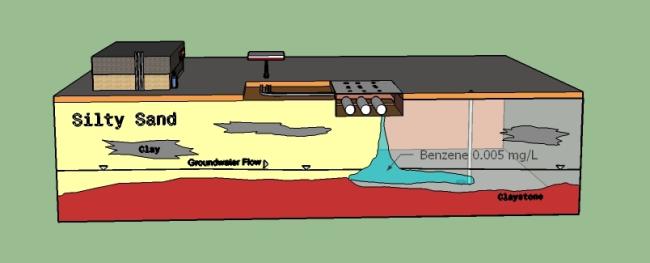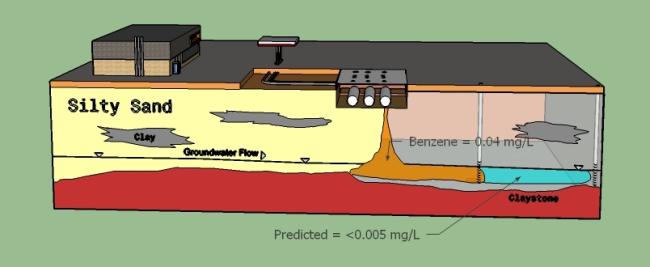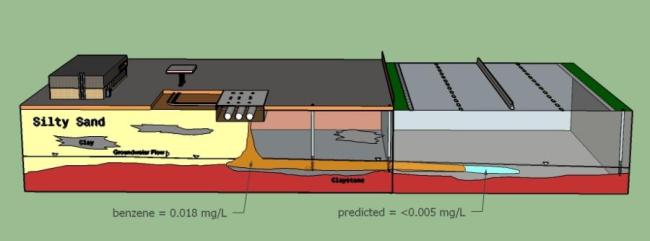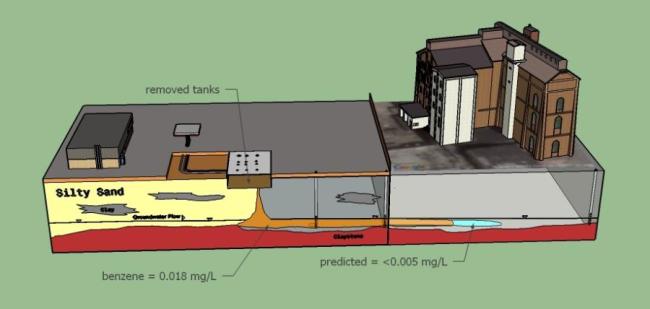Release Closure Criteria
Closure of a release event and issuance of an NFA (No Further Action) determination is based on the risk of exposure to any remaining contamination via the exposure pathways.
OPS has developed a four-tiered closure approach for petroleum releases.
- Multiple remedial actions may need to be completed to meet Tier I or II closure criteria, and it is possible that the petroleum release will not meet all of the criteria. Tier III or Tier IV closure criteria may be considered for a petroleum release that cannot achieve Tier I or II closure criteria.
- The requirements for the appropriate tier must be met prior to requesting NFA.
The information provided below is intended to assist in the evaluation of a release event based on risk to human health and the environment. Click on the arrows for more information.
Conducting site characterization that includes developing a conceptual site model is a prerequisite to requesting and issuing an NFA. OPS will issue an NFA letter once it has been demonstrated that the petroleum release is considered to be low-risk to human health and the environment. Presenting a well-developed CSM greatly enhances the likelihood of attaining an NFA determination. All NFA letters will indicate that the petroleum release was closed based on the information available at the time of the determination and on the existing exposure pathways conditions. OPS will archive petroleum releases in the OPS database and will indicate the appropriate closure criteria. A petroleum release may be reopened if exposure conditions change.
OPS has established a Tier I RBSL for each primary and select secondary COC (chemical of concern) based on the exposure pathway. The Tier I RBSLs are the first level of standards to which you should compare soil and groundwater data to determine if remedial action is warranted. They are based on the EPA drinking water standard maximum contaminant levels. Soil and groundwater must be defined to a level below the Tier I RBSL for each COC found at the site.
Tier I evaluations involve a comparison of COC concentrations to Tier I RBSLs. No further action is appropriate for a release if all COCs are below the Tier I RBSLs.
Tier I scenario
If the Tier I closure criteria cannot be met, a Tier II closure evaluation would be the next step to take.
Tier II evaluations include the collection of site data to input into fate and transport model software for the development of SSTLs (site-specific target levels). You may use Tier II evaluations to calculate on-site SSTLs for soil and groundwater, but you may not develop Tier II evaluations for off-site contamination or surficial soils.
- Fate and Transport Modeling
Predictive fate and transport models utilize site-specific data to predict how the COCs will migrate through a particular medium over time. The resultant model is then compared to existing empirical site data as a form of validation.
Default input parameters and additional fate and transport modeling information can be found in the Fate and Transport Modeling section of the Site Characterization topic.
- SSTLs (Site- Specific Target Levels)
You can develop SSTLs for on-site source areas where contamination remains above the Tier I RBSLs. You can derive Tier II SSTLs from the same equations used to calculate the Tier I RBSLs, but site-specific parameters are used in the calculations instead. The SSTL for a source area is the maximum concentration determined by a model that is predicted to be protective of the nearest POE (point of exposure) to the Tier I RBSL.
Once an SSTL is developed for a source location, compare it to the actual source data. Remedial action may be required if the actual source concentrations are above the calculated SSTL.
- Exposure Pathway Elimination
Predictive fate and transport modeling and the development of SSTLs may be utilized as lines of evidence to eliminate an exposure pathway.
The following criteria are required for elimination of an exposure pathway to be considered valid under a Tier II fate and transport model.
POEs must not be impacted by any COC above the Tier I RBSLs. Point of compliance monitoring wells must be below the Tier I RBSLs at, or prior to, the nearest POE. LNAPL (light non-aqueous phase liquid) must be removed to the maximum extent practicable. The source COC concentration input values must be representative of the source area and not under the influence of a remedial method. Post-remediation environmental monitoring must be conducted for an adequate period of time to demonstrate that the dissolved-phase plume is stable or decreasing.
- Tier II Closure Evaluation
NFA may be granted for a release when these three conditions are met.
Impacted media concentrations are lower than SSTLs for the applicable exposure pathways. Point of compliance monitoring wells upgradient of the nearest POE are below the Tier I RBSLs. Fate and transport modeling predicts that POEs will not become impacted in the future at concentrations above the Tier I RBSLs.
Tier II scenario
Tier III closure criteria establish conditions where COCs can remain above Tier I RBSLs at the release property boundary but not beyond an adjoining public roadway.
The following four criteria must be met for a petroleum release to be considered for Tier III closure.
- Contaminant Removal to the Maximum Extent Practicable
- Source area removal, dissolved-phase remediation, LNAPL abatement and any other remedial activities must be completed per the approved CAP (Corrective Action Plan) and subsequent CAP Modifications. Contaminant mass estimates should be included to represent initial mass estimates, mass removed during remediation and mass remaining in place upon a closure request.
- You may need to employ multiple remediation technologies to remove contaminant mass to meet the established remediation target goals. CAPs are not developed to meet Tier III removal criteria; instead, the goal of an approved CAP is to remediate impacted media to meet Tier I or Tier II closure criteria. Ultimately, a closure evaluation must indicate that contamination has been removed to the maximum extent practicable with consideration given to available technologies, costs and site logistics.
- Public Roadway Property Boundary is the Only Impacted POE
- A public roadway is the only POE where COC concentrations may be above the Tier I RBSLs. Point of compliance well locations must be established immediately downgradient of the public roadway.
- Present a summary of existing and planned construction activities along with an evaluation of how potential exposure pathways will be affected based on these activities.
- Post-Remediation Monitoring and Fate and Transport Modeling
- Conduct post-remediation environmental monitoring for an adequate period of time to demonstrate that dissolved-phase plume sizes and trends are stable or diminishing. Predictive fate and transport modeling, as described under Tier II criteria, must demonstrate that off-site point of compliance monitoring wells will not be impacted above the Tier I RBSLs.
- Off-site Property Owner Notification
- The owner/operator associated with the petroleum release should provide the property owner of the impacted public roadway with notification that contamination is (or is predicted to be) located beneath the public roadway.
- The owner/operator associated with the petroleum release should provide the property owner of the impacted public roadway with notification that contamination is (or is predicted to be) located beneath the public roadway.
- Tier III Closure Evaluation
-
NFA may be granted for a release if the Tier III closure criteria are met. OPS will map Tier III sites to our map on our website. This map serves to provide information to the public on any respective exposures from petroleum contaminants left in place.
Tier III scenario
Tier IV closure criteria establish conditions where COCs can remain above Tier I RBSLs at off-site properties, irrespective of land use.
The following criteria must be met for a petroleum release to be considered for Tier IV closure.
- The property on which the petroleum release originated cannot have an active petroleum storage tank system. However, exceptions to this may be granted by the Director on a case-by-case basis for newer secondarily contained petroleum storage tank systems installed less than 10 years ago that have been operating in compliance with regulations and have no reported petroleum releases.
- Contaminant Removal to the Maximum Extent Practicable
- Source area removal, dissolved-phase remediation, LNAPL abatement and any other remedial activities must be completed per the approved CAP (Corrective Action Plan) and subsequent CAP Modifications. Contaminant mass estimates should be included to represent initial mass estimates, mass removed during remediation and mass remaining in place upon a closure request.
- You may need to employ multiple remediation technologies to remove contaminant mass to meet the established remediation target goals. CAPs are not developed to meet Tier IV removal criteria; instead, the goal of an approved CAP is to remediate impacted media to meet Tier I or Tier II closure criteria. Ultimately, a closure evaluation must indicate that contamination has been removed to the maximum extent practicable with consideration given to available technologies, costs and site logistics.
- The Property Boundary is the Only Impacted POE
- A property boundary is the only POE where COC concentrations may be above the Tier I RBSL. Point of compliance locations must be established immediately upgradient of the nearest POE to the property boundary.
- Present a summary of existing and planned site uses along with an evaluation of how potential exposure pathways will be affected based on the land use.
- Post-Remediation Monitoring and Fate and Transport Modeling
- Conduct post-remediation environmental monitoring for an adequate period of time to demonstrate that dissolved-phase plume sizes and trends are stable or diminishing. Predictive fate and transport modeling, as described under Tier II criteria, must demonstrate that off-site point of compliance monitoring wells will not be impacted above the Tier I RBSLs.
- Off-site Property Owner Notification
- The owner or operator associated with the petroleum release should provide the property owners of the impacted property notification that contamination is or is predicted to be located beneath their property.
- Tier IV Closure Evaluation
-
NFA may be granted for a release if the Tier IV closure criteria are met. OPS will map Tier III sites to our map on our website. This map serves to provide information to the public on any respective exposures from petroleum contaminants left in place.
Tier IV scenario



